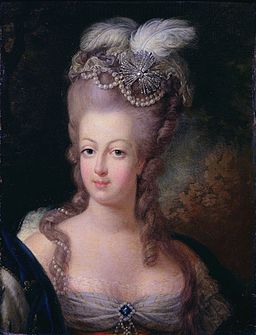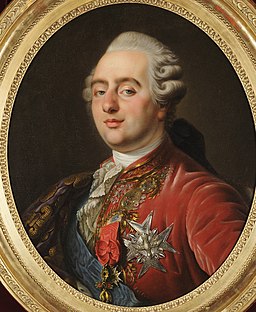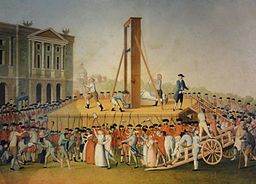Marie Antoinette was born on November 2, 1755 as Maria Antonia Josepha Johanna, at the Hofburg Palace in Vienna, Austria. In 1770, when Marie was just 14 years old, she married Dauphin Louis-Auguste, the heir to the French throne, and became Dauphine of France. Louis and Marie did not meet before their wedding and they were married by proxy with Marie's brother, Archduke Ferdinand, standing in for Louis-Auguste.
 Marie-Antoinette, 1775 - Musée Antoine Lécuyer [1]
Marie-Antoinette, 1775 - Musée Antoine Lécuyer [1]
In 1774, her husband ascended the throne to become King Louis XVI of France, making Marie Antoinette the last Queen of France before the French Revolution in 1789.
Louis XVI and Marie Antoinette had four children together. Sadly, their eldest daughter, Marie-Therese-Charlotte (1778-1851), was their only child to live past the age of ten. Louis-Joseph-Xavier-Francois (1781-1789), Louis-Charles (1785-1795), and Sophie-Helene-Beatrix (1786-1787), all died from tuberculosis.
[2]
 Louis XVI Portrait [3]
Louis XVI Portrait [3]
At first, Marie Antoinette was generally well-liked by the French people; however, over the years the starving French public grew resentful of her. She was disliked by the people that did not approve of the Franco-
Austrian alliance and they believed that she favored her native country of
Austria over France. Marie also became known for living a life of extreme luxury, pleasure and careless extravagance at a time of financial crisis. People began to blame her for the economy and France's inability to pay their crippling debts.
[4]
Several costly wars and a large royal family with extravagant habits are some of the main reasons for France's poor financial state at this time, but because the public solely blamed Marie for this, she ended up with the
nickname "
Madame Deficit" in 1787.
[2]
It was surely her notoriously lavish behavior that had so many believing that her answer to the bread crisis was to "let them eat cake", when in fact, she actually never spoke those words. As the Revolution of 1789 neared, popular hatred of Marie grew and on October 5, 1789, she was mobbed by a crowd of 60,000 infuriated women who stormed the Palace of Versailles. According to reporters, Marie was quite calm, noble and dignified, and a great number of these women were received by Marie in her drawing-room. She is quoted as having said: "I know they have come from Paris to demand my head, but I learned from my mother not to fear death and I shall await it with firmness."
On the night of June 20, 1791, King Louis XVI and Queen Marie Antoinette attempted to flee from Paris to start a counter-revolution. They only made it as far as Varennes, a small town located approximately 250 kilometers from Paris, before they were recognized and arrested. This fateful night is now referred to as The Flight of the Varennes (French:
Fuite à Varennes). After this event, the people's hatred towards the royal family became much more extreme. After returning to Paris, the family was placed on house arrest in the Tuileries palace where they were watched by the Garde Nationale at all hours of the day.
[5]
In August 1791, The Declaration of Pillnitz was given by Frederick William II of
Prussia, stating that the European powers must unite to protect the French monarchy and to declare their loyalty to King Louis XVI. This threatened France and led them to declaring war in April 1792.
On June 20, 1792, an angry mob stormed the Tuileries, where the King and Queen were being kept. This led to the Brunswick Manifesto, which was issued in July 1792 by the foreign powers that had previously declared their loyalty to France, stating that if the royal family was harmed, they would harm the French people.
[6] Once again, this was intended to scare the French civilians, but instead, it caused an even stronger revolt which caused the Insurrection of 10 August 1792. On August 10 the Tuileries was invaded by a mob of French revolutionaries that massacred the Swiss Guards.
[2]
 Marie Antoinette's execution in 1793 at the Place de la Révolution, October 16 1793 [7]
Marie Antoinette's execution in 1793 at the Place de la Révolution, October 16 1793 [7]
By September 1792 the fall of the French monarchy was officially declared and the National Convention was the first government in France. King Louis XVI of France was charged with treason, disloyalty to one's country, and sentenced to execution by guillotine. His execution took place in Paris on January 21, 1793 and it is considered one of the most significant events of the French Revolution.
[2]
Marie Antoinette was tried on October 14, 1793. The Revolutionary Tribunal declared her guilty of high treason for which she was sentenced to execution by guillotine. She was executed on October 16, 1793 at 12:15 at the age of 37. It is said that in her final years she displayed the same steadfastness, courage, and dignity of which she had spoken years earlier.
[2]
- ^ "File:Marie-Antoinette, 1775 - Musée Antoine Lécuyer.jpg." Wikimedia Commons, the free media repository. 26 Nov 2019, 23:53 UTC. https://commons.wikimedia.org/wiki/File:Marie-Antoinette,_1775_-_Mus%C3%A9e_Antoine_L%C3%A9cuyer.jpg
- ^ Fraser, Antonia. Marie Antoinette: The Journey. Weidenfeld & Nicolson, 2001.
- ^ "File:Callet. Louis XVI.jpg." Wikimedia Commons, the free media repository. 9 Jan 2020, 00:39 UTC. https://commons.wikimedia.org/w/index.php?title=File:Callet._Louis_XVI.jpg&oldid=386283802
- ^ Erickson, Carolly. To the Scaffold: The Life of Marie Antoinette. William Morrow and Company, 1991.
- ^ Lever, Evelyne. Marie Antoinette: The Last Queen of France. Portrait, 2006.
- ^ Robinson, J.H., The Proclamation of the Duke of Brunswick, 1792. Ginn and Company, 1906.
- ^ "File:Exécution de Marie Antoinette le 16 octobre 1793.jpg." Wikimedia Commons, the free media repository. 9 Aug 2019, 13:03 UTC. https://commons.wikimedia.org/w/index.php?title=File:Ex%C3%A9cution_de_Marie_Antoinette_le_16_octobre_1793.jpg&oldid=361221841
- ^ Swyrich, Archive materials.


